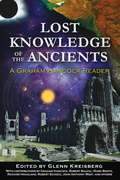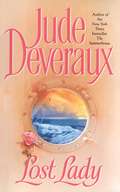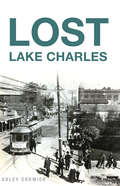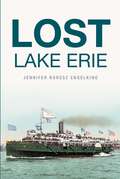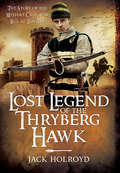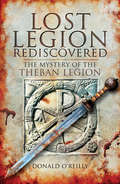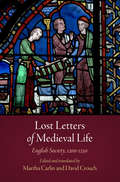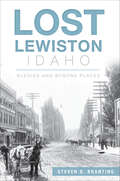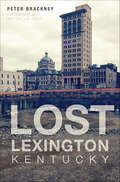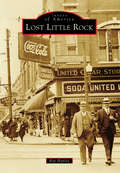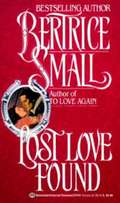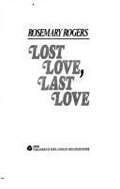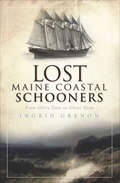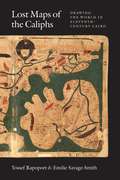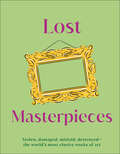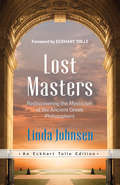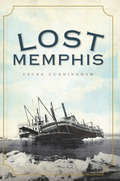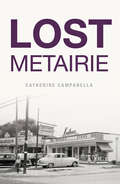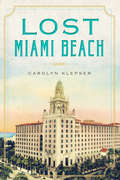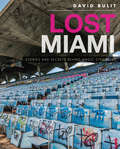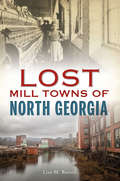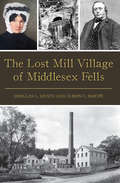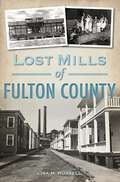- Table View
- List View
Lost Knowledge of the Ancients: A Graham Hancock Reader
by Glenn KreisbergThinkers at the forefront in alternative theories on history, the origins of civilization, technology, and consciousness • With contributions by Graham Hancock, Robert Bauval, Mark Booth, Richard Hoagland, Robert Schoch, John Anthony West, and others • Topics range from quantum philosophy and paranormal phenomena to the secret history of NASA, instant polar shifts, and ancient Martian civilizations • Explores where our present time fits into the cycle of human existence A revolution of thought is under way in our world, fostered by decades of research and well-documented evidence by alternative theory pioneers such as Graham Hancock, John Anthony West, Robert Bauval, and Robert Schoch. These provocative, cutting-edge scholars now represent a direct challenge to the academic establishment as the paradigms of science and history shift and their ideas gain acceptance. Representing the latest, often controversial findings in scientific and historical research, this anthology of essays commissioned by Graham Hancock, bestselling author of Fingerprints of the Gods, covers the forefront in alternative theories on history, the origins of civilization, technology, and consciousness with topics ranging from quantum philosophy and paranormal phenomena to the ancient use of electromagnetism, the effect of cosmic rays on human evolution, and NASA’s cover-up of ancient Martian civilizations. Recognizing that many recent discoveries are actually rediscoveries of lost knowledge from past civilizations, these authors seek to understand where, within the bigger picture of human knowledge, our present time fits into the cycle of human existence.
Lost Lady
by Jude DeverauxNew York Times bestselling author Jude Deveraux touches the heart with this captivating novel of unexpected passion, adventure, and second chances. Forsaken by her guardian and narrowly escaping marriage to a money-hungry suitor, Regan flees Weston Manor, the only home she's ever known, determined to rule her own destiny. When Travis Stanford, a big, rugged American, finds Regan on London's docks, he vows to protect her—unaware of the magnificent, iron-willed beauty she would become, or the dangerous, passion-filled future that awaited them both. From England's bawdy wharves to Virginia's elegant mansions, their love was kindled by chance, and flamed by the thrilling pursuit of unknown tomorrows.
Lost Lake Charles (Lost)
by Adley CormierFires, hurricanes, neglect and progress erased much of Lake Charles’s physical history. The young town was a magnet for pirates and privateers, like the infamous Jean Lafitte, who conducted business at the mouth of what is today called the Contraband Bayou. Michigan Men, creoles and cowboys made their way to the fledgling Louisiana town to start new lives. A great lumber industry shaped the town in the nineteenth century. Streetcars ran routes around the clock seven days a week. Author and historian Adley Cormier delves deep into Lake Charles’s past to uncover a history that has been lost to time and change.
Lost Lake Erie (Lost)
by Jennifer Boresz EngelkingSerene one moment and destructive the next, Lake Erie's moods mirror its tumultuous role in history. As the site of Cleveland's Great Lakes Exposition, the lake offered visitors a respite from the Great Depression, and Hotel Victory, once considered the world's largest summer resort, drew thousands to Put-In-Bay. Daring postal workers dangerously crossed the ice-covered surface on hybrid "boats" and by foot. Canal Street, at the Buffalo Wharf, was once called "the Wickedest Street in America." The Erie is one of thousands of ships that lie in a solemn graveyard below the surface. And rum runners turned the lake into a watery highway for illegal booze during Prohibition. Author Jennifer Boresz Engelking reveals entertaining, heartbreaking, and nostalgic stories of the lost sites, businesses and industries of Lake Erie.
Lost Legend of the Thryberg Hawk: The Mystery Crossbow Boy who Saved the Fortunes of York at the Battle of Towton
by Jack HolroydMarksmanship skills honed to perfection, driven by necessity and desperation, Edmund Hawksworth hunted with his crossbow to keep his ailing mother alive, only to have her die in his arms. Deserted by his father who had left to fight the Lancastrian cause, the embittered and determined lad set out on a mission of vengeance and became embroiled in the bitter struggle for the throne of England between the Houses of Lancaster and York. There were those in 1461 who avowed that Edmund had been divinely chosen and anointed to be the Avenger of Righteous Blood something the boy himself never claimed. What is certain, in command of the Wespen (Wasps), an lite unit of crossbow mercenaries, he turned events in York's favour at the decisive Battle of Towton. Despite protests from Yorkist lords, King Edward IV (himself a youth of eighteen), gave the accolade to the former herder of pigs from Thryberg declaring him to be 'The truest and most loyal knight in all England'. With the end of the Plantagenet dynasty and the ascent of the Lancastrian Tudors the many stories of the Yorkist boy hero were supressed. However, for fifty years fanciful tales of 'The Hawk' lingered on in the towns and villages of the West Riding of Yorkshire until in 1509 Edmund's brother arrived in chains at Conisbrough Castle. Before his burning in Doncaster Fish Market the condemned heretic tells the true story of the Lost Legend of the Hawk.
Lost Legion Rediscovered: The Mystery of the Theban Legion
by Donald O'ReillyIn AD383, according to Bishop Eucherius of Lyon, flooding caused part of the bank of the River Rhone to collapse, revealing a massed grave of thousands of bodies. Eucherius identified these as a legion recruited for the Roman army from the Christians of the Theban district in Egypt, whom he claimed had been massacred nearly a century previously (near the modern village of St Maurice-en-Valais in southwestern Switzerland) for refusing to obey orders they considered immoral. This incident, asserted by Eucherius as matter of fact, is unrecorded elsewhere. Even the existence of this Theban legion is unclear.
Lost Letters of Medieval Life
by Martha Carlin David CrouchEveryday life in early thirteenth-century England is revealed in vivid detail in this riveting collection of correspondence of people from all classes, from peasants and shopkeepers to bishops and earls. The documents edited here include letters between masters and servants, husbands and wives, neighbors and enemies, and cover a wide range of topics: politics and war, going to fairs and going to law, attending tournaments and stocking a game park, borrowing cash and doing favors for friends, investigating adultery and building a windmill.While letters by celebrated people have long been known, the correspondence of ordinary people has not survived and has generally been assumed never to have existed in the first place. Martha Carlin and David Crouch, however, have discovered numerous examples of such correspondence hiding in plain sight. The letters can be found in manuscripts called formularies--the collections of form letters and other model documents that for centuries were used to teach the arts of letter-writing and keeping accounts.The writing-masters and their students who produced these books compiled examples of all the kinds of correspondence that people of means, members of the clergy, and those who handled their affairs might expect to encounter in their business and personal lives. Tucked among the sample letters in these formularies from popes to bishops and from kings to sheriffs are examples of a much more casual, ephemeral kind of correspondence. These are the low-level letters that evidently were widely exchanged, but were often discarded because they were not considered to be of lasting importance. Two manuscripts, one in the British Library and the other in the Bodleian Library, are especially rich in such documents, and it is from these collections that Carlin and Crouch have drawn the letters and other documents in this volume. They are presented here in their first printed edition, both in the original Latin and in English translation, each document splendidly contextualized in an accompanying essay.
Lost Lewiston, Idaho: Elegies and Bygone Places (Lost)
by Steven D. BrantingLewiston has a proud heritage of historic preservation. Yet, as with other communities, it has neglected and thrown away once-treasured landmarks and precious memories with the passage of time. Some legacies were crafted with brick and mortar, others with flesh and blood. Nothing is permanent unless we make it so. Join award-winning historian Steven D. Branting as he takes a focused look at some of Lewiston's bygone edifices and the ambitious civic leaders and craftsmen who fashioned them. Reconnect with the city's scholars, its pious, its dreamers and one desperate teenager. They all made Lewiston what it once was, bequeathed their present to be our past and have sadly faded from our view.
Lost Lexington, Kentucky (Lost)
by Peter BrackneyLexington has dozens of well-restored landmarks, but unfortunately so many more are lost forever.The famous Phoenix Hotel, a longtime stop for weary travelers and politicians alike, has risen from its own ashes numerous times over the past centuries. The works of renowned architect John McMurtry were once numerous around town, but some of the finest examples are gone. The Centrepointe block has been made and unmade so many times that its original tenants are unknown to natives now. Join local blogger, attorney and preservationist Peter Brackney as he explores the intriguing back stories of these hidden Bluegrass treasures.
Lost Little Rock
by Ray HanleyLittle Rock is a sprawling city of about 200,000 at the center of a metropolitan area of more than 500,000 people, with many residing in bedroom communities in adjoining counties. Arkansas's capital city is much like the rest of Middle America with its outlying suburbs, gated communities, and shopping centers miles from the historic core. A century ago, however, Little Rock was markedly different and served a population of fewer than 50,000. The majority of citizens lived within blocks of the town center and did business downtown along rows of shops that, in many cases, dated to the late 1800s. Images of America: Lost Little Rock uses vintage photographs to reflect upon earlier times and the rich retail landscape that once filled the town. By exploring the legacies of buildings that have since been demolished, repurposed, or destroyed by fire, these images provide a sense of Little Rock's lesser-known heritage.
Lost Love Found: A Novel (O'Malley Saga #5)
by Bertrice SmallDespite her breathtaking appearance at Queen Elizabeth's court, Valentina's innocence was shattered when she discovered that her true father may have been the lusty Sultan Murad of Istanbul. Needing to learn more, she set sail for the East in a dangerous erotic journey toward the truth...."Bertrice Small creates cover-to-cover passion, a keen sense of history and suspense."PUBLISHERS WEEKLYFrom the Paperback edition.
Lost Love, Last Love
by Rosemary RogersTHE FEVER! THE FIRE! THE ECSTASY! Theirs was a love that could never be tamed, yet the whims of fate and their own reckless desires were destined to tear Virginia Brandon and Steven Morgan from the rapturous heights of reunion--and carry them to opposite ends of the earth. Through the fiery tumult of the Cuban Revolution to the lush prison of a Sultan's harem, across burning desert sands and Europe's most provocative boudoirs, the lovers pursue their separate fates. Until, in a mounting tide of restless longing, the sweet fires of their exalted love draw them closer, burning brighter, across time, across worlds--in the ultimate marriage of lust and love!
Lost Maine Coastal Schooners: From Glory Days to Ghost Ships (Lost Ser.)
by Ingrid GrenonDramatic true stories of New England maritime history, with photos. Large, wooden-hulled schooners graced the seas of coastal Maine for more than a century as vessels of trade and commerce. With the advent of steam-powered craft, however, these elegant four-, five-, or six-masted wooden ships became obsolete and vanished from the harbors and horizons. The Edward Lawrence, the last of the six-masters, became her own funeral pyre in Portland Harbor, burning to ash before everyone&’s eyes. The Carroll A. Deering washed ashore with no trace of her crew, empty as a ghost ship except for three cats and a pot of pea soup still cooking on the stove. In this testament to the beauty of the Maine coastal region, maritime history enthusiast Ingrid Grenon tells the story of these magnificent relics of the bygone Age of Sail and celebrates the people who devoted their lives to the sea.
Lost Maps of the Caliphs: Drawing the World in Eleventh-Century Cairo
by Yossef Rapoport Emilie Savage-SmithAbout a millennium ago, in Cairo, an unknown author completed a large and richly illustrated book. In the course of thirty-five chapters, this book guided the reader on a journey from the outermost cosmos and planets to Earth and its lands, islands, features, and inhabitants. This treatise, known as The Book of Curiosities, was unknown to modern scholars until a remarkable manuscript copy surfaced in 2000.Lost Maps of the Caliphs provides the first general overview of The Book of Curiosities and the unique insight it offers into medieval Islamic thought. Opening with an account of the remarkable discovery of the manuscript and its purchase by the Bodleian Library, the authors use The Book of Curiosities to re-evaluate the development of astrology, geography, and cartography in the first four centuries of Islam. Their account assesses the transmission of Late Antique geography to the Islamic world, unearths the logic behind abstract maritime diagrams, and considers the palaces and walls that dominate medieval Islamic plans of towns and ports. Early astronomical maps and drawings demonstrate the medieval understanding of the structure of the cosmos and illustrate the pervasive assumption that almost any visible celestial event had an effect upon life on Earth. Lost Maps of the Caliphs also reconsiders the history of global communication networks at the turn of the previous millennium. It shows the Fatimid Empire, and its capital Cairo, as a global maritime power, with tentacles spanning from the eastern Mediterranean to the Indus Valley and the East African coast. As Lost Maps of the Caliphs makes clear, not only is The Book of Curiosities one of the greatest achievements of medieval mapmaking, it is also a remarkable contribution to the story of Islamic civilization that opens an unexpected window to the medieval Islamic view of the world.
Lost Masterpieces: The World's Forgotten Masterpieces, from Stolen to Destroyed
by DKDiscover the extraordinary stories behind the world&’s missing works of art.Travel back in time to discover works of art that have vanished from the record, as well as those that went missing and have since been reclaimed or recovered. From the treasures of Tutankhamun to the altarpiece of Ghent, a missing Fabergé egg, and Vincent van Gogh&’s majestic Sunset at Montmajour, numerous masterpieces have disappeared throughout history as a result of theft, looting, natural catastrophe, or conflict… And some have resurfaced decades or even centuries later!Lost Masterpieces examines the unique story of the most significant of these artworks, the artists who created them, and those thought to be involved in their loss. It explores the various means by which museum curators and international crime investigators have unearthed missing treasures. It highlights the moral dilemma of museums that have profited from looted works of art and examines the recent &“heists&” made by some nations in an effort to regain their nation&’s stolen works of art.This awe-inspiring art history book promises:- A selection of the most important &“lost&” cultural artifacts from ancient times to the present day- Features images of the artworks where available, or specially commissioned illustrations of them based on written accounts-Includes details of the ongoing debate about whether looted art should be returned to its country of originDelve into the mysteries of ancient Egyptian tombs, marvel at the hoards unearthed by archaeologists, and discover the skulduggery behind the disappearance of priceless Rembrandts and Vermeers, and see the world of art and antiquities in a whole new light! A must-have volume for adults and young adults with an interest in art, culture and history, whether you&’re an art or history student, a collector of art antiques, or you&’re simply a curious lifelong learner, Lost Masterpieces is sure to delight.
Lost Masters: Rediscovering the Mysticism of the Ancient Greek Philosophers (An Eckhart Tolle Edition)
by Linda JohnsenAshrams in Europe twenty-five hundred years ago? Greek philosophers studying in India? Meditation classes in ancient Rome? It sounds unbelievable, but it’s historically true. Alexander the Great had an Indian guru. Pythagoras, Empedocles, and Plotinus all encouraged their students to meditate. Apollonius, the most famous Western sage of the first century c.e., visited both India and Egypt—and claimed that Egyptian wisdom was rooted in India. In Lost Masters, award-winning author Linda Johnsen, digging deep into classical sources, uncovers evidence of astonishing similarities between some of the ancient Western world’s greatest thinkers and India’s yogis, including a belief in karma and reincarnation. Today ancient Greek philosophers are remembered as the founders of Western science and civilization. We’ve forgotten that for over a thousand years they were revered as sages, masters of spiritual wisdom. Lost Masters is an exploration of our long-lost Western spiritual heritage and the surprising insights it can offer us today.
Lost Memphis
by Laura CunninghamMemphis is a city founded on some of the great vestiges of our past. City staples such as steamboats, cotton plantations and exchange centers, relics symbolic of the city's rich industrial and agrarian legacy, have either been forgotten or completely lost. Every city, especially one as thoroughly modern as Memphis, naturally loses even the more recent aspects of its past through growth and expansion. Join Memphian and library historian Laura Cunningham as she unearths the lost hallmarks of Memphis, from the city's earliest beginnings to the present. Filled with rare and archival images that range from whimsical to haunting, Lost Memphis provides a glimpse into the vanished landmarks and bygone ways of life that once defined the city. Though the people and places featured in Lost Memphis are gone, this collection of compelling photos ensures that they will never be truly lost to history.
Lost Metairie (Lost)
by Catherine CampanellaFrom ancient bayous to beloved old businesses, Metairie has changed dramatically over generations. And many of those landmarks are lost to time. The lake, railroads and a beach resort were popular features in the early days. A streetcar ran through the short-lived City of Metairie Ridge, where gambling houses and dog tracks contributed more tax dollars than did the few residents. Old Bucktown was famous for its seafood. Fat City, once notorious for its nightlife, has seen better days. Author Catherine Campanella takes a look back at the schools, shops, bars, restaurants, alligator farms, bowling alleys, drive-ins and movie theaters from a bygone era.
Lost Miami Beach (Lost)
by Carolyn KlepserMiami Beach has been "America's Playground" for a century. Still one of the world's most popular resorts, its 1930s Art Deco architecture placed this picturesque city on the National Register of Historic Places. Yet a whole generation of earlier buildings was erased from the landscape and mostly forgotten: the house of refuge for shipwrecked sailors, the oceanfront mansions of Millionaires' Row, entrepreneur Carl Fisher's five grand hotels, the Community Theatre, the Miami Beach Garden and more. Join historian Carolyn Klepser as she rediscovers through words and pictures the lost treasures of Miami Beach and recounts the changes that sparked a renowned preservation movement.
Lost Miami: Stories and Secrets Behind Magic City Ruins (Lost)
by David BulitMiami architecture is world renowned, but many historic treasures have been forgotten. The Richmond Naval Air Station was a blimp base destroyed by hurricane in 1945. A Cold War missile base lies covered in graffiti. Homestead's old Aerojet complex was originally used in the testing and construction of experimental rockets but was slowly demolished as part of a project to revitalize the Everglades. The Miami Marine Stadium was declared unsafe after Hurricane Andrew in 1992 and stands abandoned today. Author and "Abandoned Florida" blogger David Bulit revives the history and secrets of the Magic City's vanishing gems.
Lost Mill Towns of North Georgia (Lost)
by Lisa M. RussellThe textile era was born of a perfect storm. When North Georgia's red clay failed farmers and prices fell during Reconstruction, opportunities arose. Beginning in the 1880s, textile industries moved south. Mill owners enticed an entire workforce to leave their farms and move their families into modern mill villages, encased communities with stores, theaters, baseball teams, bands and schools. To some workers, mill village life was idyllic. They had work, recreation, education, shopping and a home with the modern conveniences of running water and electricity. Most importantly, they got a paycheck. But after the New Deal, workers started to see the raw deal they were getting from mill owners and rebelled. Strikes and economic changes began to erode the era of mill villages, and by the 1960s, mill village life was all but gone. Author Lisa Russell brings these once-vibrant communities back to life.
Lost Mill Village of Middlesex Fells, The (Brief History)
by Alison C. Simcox Douglas L. HeathOne of the earliest mill communities in the Massachusetts Bay Colony formed along Spot Pond Brook, a few miles north of Boston. Thomas Coytmore built the first mill in 1640 at the brook’s downstream end in “Mistick Side” (present-day Malden). Other mills sprang up along the brook as well. Today, most of Spot Pond Brook is hidden in culverts beneath the busy streets of Malden and Melrose. However, remnants of the lost mill village of Haywardville—foundations, millruns and ponds and waterfalls—are preserved within Middlesex Fells Reservation, part of Boston’s world-famous Metropolitan Park System. Authors Douglas L. Heath and Alison C. Simcox trace the history of this thriving early American community.
Lost Mills of Fulton County (Lost)
by Lisa M. RussellLabor conflicts, arrests, espionage—it was all there at the once ubiquitous mills of Fulton County.Employee records and snatches of paper prove workers spied on each other. Company owners were paranoid about labor unions taking over. Copious documentation, unearthed here by author Lisa M. Russell, brings the workaday drama back to life. These mills sustained families, but exploitation was far from uncommon. When mill workers finally went on strike, there was hell to pay. The company bosses yanked strikers from their shacks. With the help of Governor Talmadge, the National Guard arrested working women with their children. They marched these "criminals" to a former WWI prisoner of war camp that once held enemy German soldiers. Hard to believe this was happening in and around Atlanta in the early 1900s.
Lost Milwaukee (Lost)
by Carl SwansonFrom City Hall to the Pabst Theater, reminders of the past are part of the fabric of Milwaukee. Yet many historic treasures have been lost to time. An overgrown stretch of the Milwaukee River was once a famous beer garden. Blocks of homes and apartments replaced the Wonderland Amusement Park. A quiet bike path now stretches where some of fastest trains in the world previously thundered. Today's Estabrook Park was a vast mining operation, and Marquette University covers the old fairgrounds where Abraham Lincoln spoke. Author Carl Swanson recounts these stories and other tales of bygone days.
Lost Minden (Images of America)
by John A. AganMinden has transformed quite a bit since Charles Vedeer founded it in 1835. The town has suffered damages of the Civil War and Reconstruction and between 1872 and 1933 the devastation of five fires and a killer tornado. Despite disaster, Minden continues to progress, but adaptation and rebuilding have caused many familiar landmarks to vanish from the local landscape. The 1902 fire led to the enactment of a city ordinance banning wooden structures downtown; as a result, many edifices were reconstructed. Today, not a single building in the business district predates the 1870s, and the roles of those still standing--such as the First National Bank, which is expected to reopen as a restaurant--are continually changing. In 1918, another fire destroyed the Minden Lumber Mill, the town's largest industry. Later in the 20th century, the development of a city government complex demolished an entire shopping district, the 1905 Webster Parish Courthouse, and Minden City Hall. Lost Minden captures catastrophes, celebrations, storefronts, and back streets that otherwise only remain in memories. ?John Agan is a lifelong Minden resident who has been actively involved in local history writing and research for more than 30 years. In the course of these activities, he accumulated most of the vintage photographs in this volume that depict the Minden that has since been "lost."
